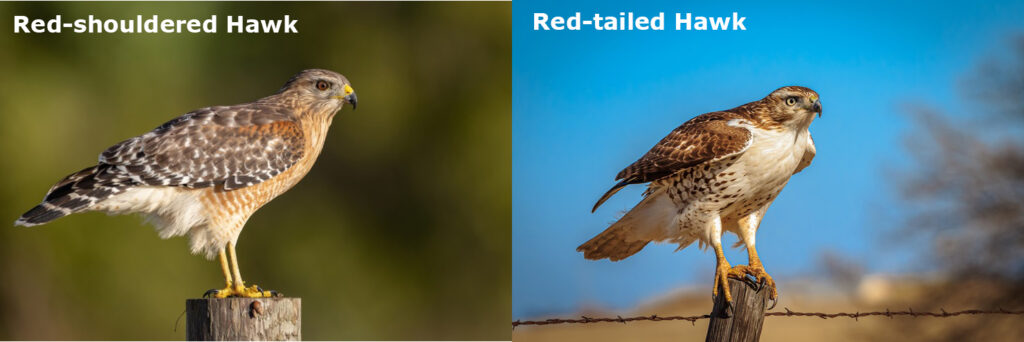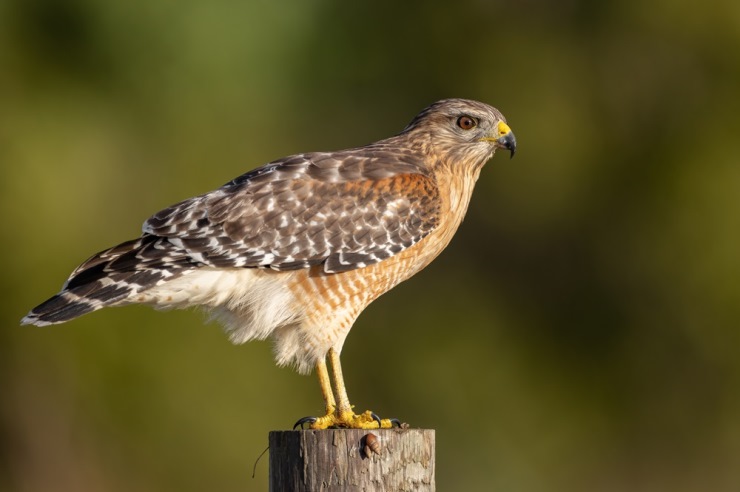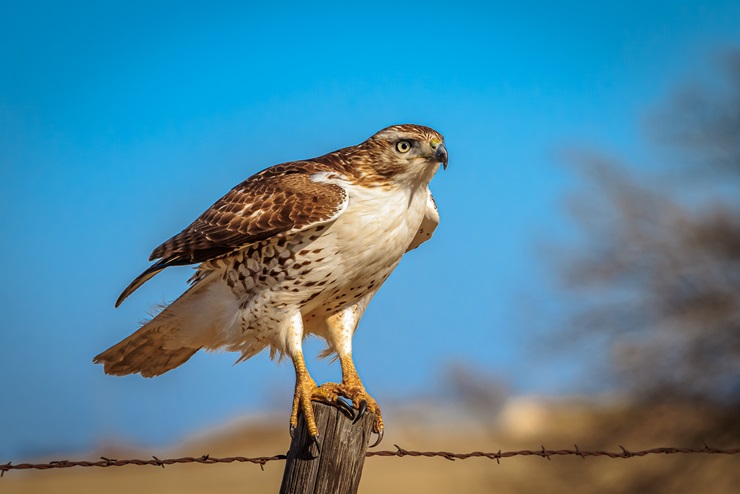There are few sights more beautiful or hypnotizing than a soaring hawk: the effortless command, the taut watchfulness, visible even from the ground – and if you’re lucky, the heart-stopping swoop of a bird descending on its prey.
In the United States, our largest hawks are all in the genus Buteo, whose members are chiefly soaring hunters of open ground. These include two of our most common birds of prey, the Red-tailed Hawk (B. jamaicensis) and the Red-shouldered Hawk (B. lineatus), which are nearly ubiquitous across the eastern United States.
As you might expect from such closely-related species, the two birds have similar appearances, and where their ranges overlap it’s easy to get them confused.
The Red-shouldered Hawk’s smaller size and long tail, as well as its boldly patterned upper plumage, will help you to distinguish it from an adult Red-tailed Hawk without much trouble. However, special care should be taken in identifying juvenile birds, which may not fit these general rules.

Range and Distribution
Although most buteos hunt in open country like grasslands and savanna, Red-shouldered Hawks are primarily woodland hunters and are most at home in riparian forests. Their range is restricted to eastern North America, where rivers and deciduous forests are abundant, with an isolated subspecies in western California.
Red-tailed Hawks, in contrast, are classic buteos, and their predilection for open habitats makes them common throughout the continent. They’re among the most widely distributed raptors in North America: year-round residents in all 48 contiguous states, during breeding season they can be found as far north as the Arctic Circle.
The niches these two birds occupy differ enough that you’ll probably see them in different locations, but these aren’t set in stone. You can certainly find Red-tails in habitats more characteristic of Red-shouldered Hawks and vice versa.
Vocalizations
Raptors don’t sing, using vocalizations primarily to communicate with one another, so most of the time they’re fairly quiet.
However, the species have such distinct sounds that it’s worth knowing the differences, because in cases where the bird’s appearance is uncharacteristic of the species or you can’t get a good look, sound may be able to provide a conclusive ID.
Of the two species, the Red-shouldered Hawk is the more talkative. It will call insistently both for communication and to express agitation, whether from a potential mate, a rival, or a threat.
Red-tailed Hawks are far less vocal than Red-shouldered Hawks, but when they do vocalize it’s impossible to miss: a harsh, piercing scream that’s generally given in flight.
It’s a sound many Americans associate with the Bald Eagle, the result of years of irresponsible movie and TV sound effects – but it properly belongs to the Red-tail, and even in the absence of any other information it should be enough to make an ID.
Song of the Red-shouldered Hawk:
Call of the Red-shouldered Hawk:
Song of the Red-tailed Hawk:
Call of the Red-tailed Hawk:
Size and Shape
One obvious difference between Red-tailed and Red-shouldered Hawks is size.
Although they don’t differ much in length, the Red-tailed Hawk has a much greater wingspan.
They differ in weight, too: female Red-tailed Hawks are among the largest raptors in North America, while Red-shouldered Hawks fall in the upper middle size range. However, adult Red-shouldered Hawks are comparable in size to juvenile Red-tails, so pay attention to shape and plumage as well.
The two birds have different shapes, adapted to their methods of hunting. Red-shouldered Hawks have long tails, nearly half their total length, which act like rudders for maneuvering among trees in pursuit of prey. Red-tailed Hawks, which spend much of their time soaring, have short and wide tails, barely reaching past their extended talons.
The Red-tailed Hawk is generally a stockier, heftier bird than the Red-shouldered, which is comparatively lean and streamlined – it’s the difference between a bird that hunts by brute force and one that relies on ambush.
When soaring, these differences in size and shape are unmistakable, but even a perched bird will give plenty of clues to its identity, if not in shape then in color.


Plumage
Red-shouldered Hawks are fairly consistent in plumage, even among widely separated subspecies. A perched bird has a checkered black-and-white back, due to its striped primaries; in flight these are quite striking, and set it apart easily from the more uniform wings of the Red-tailed Hawk.
The rusty shoulders from which the bird takes its name extend to the breast and belly, with white spotting similar to the back. The vent (the area under the tail and around the legs) is white, but this is usually only visible in soaring birds. The tail is mostly black with five to ten thin white stripes and is quite distinctive in flight.
Because they are so widespread, Red-tailed Hawks can differ as much from each other as they do from other species. There are at least 14 subspecies throughout North America and the Caribbean, and they range from nearly all black to very light, almost white.
Untangling these subspecies would require an article of its own, but the good news is that only one subspecies overlaps significantly with the Red-shouldered Hawk, Buteo jamaicensis borealis.
Fortunately, this is the subspecies with the most “classic” color scheme of Red-tails, and for adult birds, the general scheme can be relied on pretty much anywhere the two species overlap.
Red-tails are dark brown above, often mottled indistinctly (not checkered like the Red-shouldered) with lighter hues, and have white breasts marked with a V-shaped girdle of dark feathers across the chest.
Most Red-tails in flight appear uniformly light-colored below, with dark-edged wings, and two dark “commas” adjacent to the shoulders.
The rusty red tail from which the bird takes its name is present in most individuals, but keep in mind that juveniles have barred tails, which combined with their smaller size makes them easy to confuse with Red-shouldered Hawks.
The important thing to remember is that the tails of juvenile Red-tails have many (20 or more) narrow and equal black and white stripes, while the tails of Red-shouldered Hawks are mostly black with a few (less than 10) thin white stripes.
Conclusion
Distinguishing Red-tailed and Red-shouldered Hawks isn’t challenging under most circumstances, but it’s not always straightforward.
Although they generally occupy different habitats, any birder in the eastern US is likely to encounter both, and you may even see them together. When you do, differences in size and shape are useful for distinguishing soaring birds, and plumage is usually reliable for perched birds.
The truth is, however, that sometimes none of these characters will be absolutely conclusive. This is especially true for juvenile Red-tails, which differ substantially in coloring and pattern from adults, and lack both the characteristic red tails and dark-edged wings of adults.
These cases are challenges, but they’re also valuable learning opportunities, particularly if you are able to get photographs or recordings of vocalizations. Even if you aren’t able to nail down a specific ID, you’ll at least have had the opportunity to observe one of these majestic and powerful creatures, which in itself can be a moving and fascinating experience!
Red-Shouldered Hawk vs Red-Tailed Hawk: COMPARISON TABLE
| Red-Shouldered Hawk | Red-Tailed Hawk | |
|---|---|---|
| Scientific name | Buteo lineatus | Buteo jamaicensis |
| Native status | Native | Native |
| Length | Both sexes: 43-61 cm (16.9-24 in) | Males: 45-56 cm (17.7-22.1 in); f Females: 50-65 cm (19.7-25.6 in) |
| Wingspan (both sexes) | 94-111 cm (37-43.7 in) | 114-133 cm (44.9-52.4 in) |
| Weight (both sexes) | Both sexes: 490-780 g (17.1-27.3 oz) | Males: 700-1300 g (24.5-50 oz); Females: 900-1460 g (31.8-51.5 oz) |
| Habitat | Deciduous forests, especially riparian woodlands with open understory; also swamps, mixed hardwood-conifer forests, and suburban areas and open ground near woodlands | Open country: grasslands, savanna, and suburban areas, including agricultural fields and roadsides |
| Diet | Small mammals, reptiles, and amphibians; occasionally large invertebrates like crayfish and insects | Mostly mammals, in size up to 5 pounds; also birds and occasionally carrion |
| Coloring (female only) | Checkered black and white above with pale orange shoulders; breast and belly checkered with orange and white; tails mostly black with 5-10 thin white stripes | Mottled dark brown above, pale below with a girdle of dark feathers around the chest; adults usually have rusty-red tails that are densely striped in juveniles |
| Vocalization (female only) | Hiccuping screech similar to a Blue Jay, given insistently when alarmed or agitated | Long, piercing kee-ah , given singly, usually in flight |
| Bill | Smaller than Red-tailed but similarly proportioned, with prominent yellow cere | Large, with a prominent hook; generally uniform gray to blue-gray |
